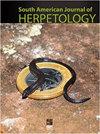Helminth Community in the Llanos Frog, Lepidobatrachus llanensis (Ceratophryidae), from the Dry Chaco
IF 0.7
4区 生物学
Q4 ZOOLOGY
引用次数: 1
Abstract
Abstract. The present study predicts that helminth community diversity and parasite transmission are influenced by host behavior and its habitat. This prediction was tested by analyzing for the first time the helminth community of Lepidobatrachus llanensis, an aquatic species that inhabits exclusively ephemeral water bodies in the Dry Chaco ecoregion. In the drought periods, L. llanensis burrows underground and forms a cocoon to minimize water loss, emerging again in the rainy season (e.g., in summer months). A total of 21 frogs was examined for parasites. Parasite community structure was analyzed using helminth parasite richness, diversity, and abundance. The helminth community of this frog consisted of 17 species, composed mostly of platyhelminth species (76%), followed by nematodes (24%). Ophiotaenia sp. was most prevalent (71%, confidence interval [CI]: 51.4–90.6%), followed by Choledocystus elegans (57%, CI: 35.8–78.2%). Infected frogs harbored a maximum of seven helminth species. At the infracommunity level, the mean species richness was 4.24 ± 1.79 per infected frog. Parasites were found in all major organs, with highest prevalence in the body cavity. Helminth species showed a typical aggregated pattern of distribution with unequal abundances. Parasite transmission to the frog host occurs by oral ingestion and skin penetration. As predicted, we found that the composition of the parasite community of this aquatic frog included multiple helminths, including parasitic species characteristic of both aquatic and terrestrial life cycles, with greater occurrence of trematodes that likely benefit from seasonal host aggregation during the rainy period associated with their reproductive strategies and by environmental factors such as seasonal dwelling in dry soil. This behavior in an otherwise aquatic frog enables infections by nematodes (L3) with a terrestrial life cycle absent from other aquatic frogs from South America.干chaco地区Llanos蛙Lepidobatrachus llanensis(蠓科)的蠕虫群落
摘要本研究预测,寄主行为和寄主栖息地对寄生虫群落多样性和传播有影响。这一预测通过首次分析Lepidobatrachus llanensis的蠕虫群落进行了验证,Lepidobatrachus llanensis是一种栖息在干查科生态区短暂水体中的水生物种。在干旱时期,L. llanensis在地下挖洞并形成茧以减少水分流失,在雨季(例如夏季)再次出现。共对21只青蛙进行了寄生虫检查。利用寄生虫丰富度、多样性和丰度等指标分析寄生虫群落结构。该蛙的蠕虫群落共有17种,其中以扁形蠕虫居多(76%),线虫次之(24%)。以蛇带绦虫(Ophiotaenia sp.)最常见(71%,可信区间[CI]: 51.4 ~ 90.6%),其次为秀丽胆docystus elegans (57%, CI: 35.8 ~ 78.2%)。受感染的青蛙最多可携带七种寄生虫。群落内物种丰富度平均为4.24±1.79 /只。主要脏器均有寄生,以体腔居多。蠕虫种呈典型的聚集分布模式,丰度不等。寄生虫通过口服摄入和皮肤渗透传播到青蛙宿主。正如预测的那样,我们发现这种水生青蛙的寄生虫群落组成包括多种寄生虫,包括水生和陆地生命周期的寄生物种,其中吸虫的出现更多,这可能得益于雨季宿主的季节性聚集,以及它们的繁殖策略和干燥土壤的季节性居住等环境因素。其他水生蛙的这种行为使线虫(L3)感染,这些线虫具有南美洲其他水生蛙所没有的陆地生命周期。
本文章由计算机程序翻译,如有差异,请以英文原文为准。
求助全文
约1分钟内获得全文
求助全文
来源期刊
CiteScore
1.50
自引率
0.00%
发文量
10
期刊介绍:
The South American Journal of Herpetology (SAJH) is an international journal published by the Brazilian Society of Herpetology that aims to provide an effective medium of communication for the international herpetological community. SAJH publishes peer-reviewed original contributions on all subjects related to the biology of amphibians and reptiles, including descriptive, comparative, inferential, and experimental studies and taxa from anywhere in the world, as well as theoretical studies that explore principles and methods.

 求助内容:
求助内容: 应助结果提醒方式:
应助结果提醒方式:


